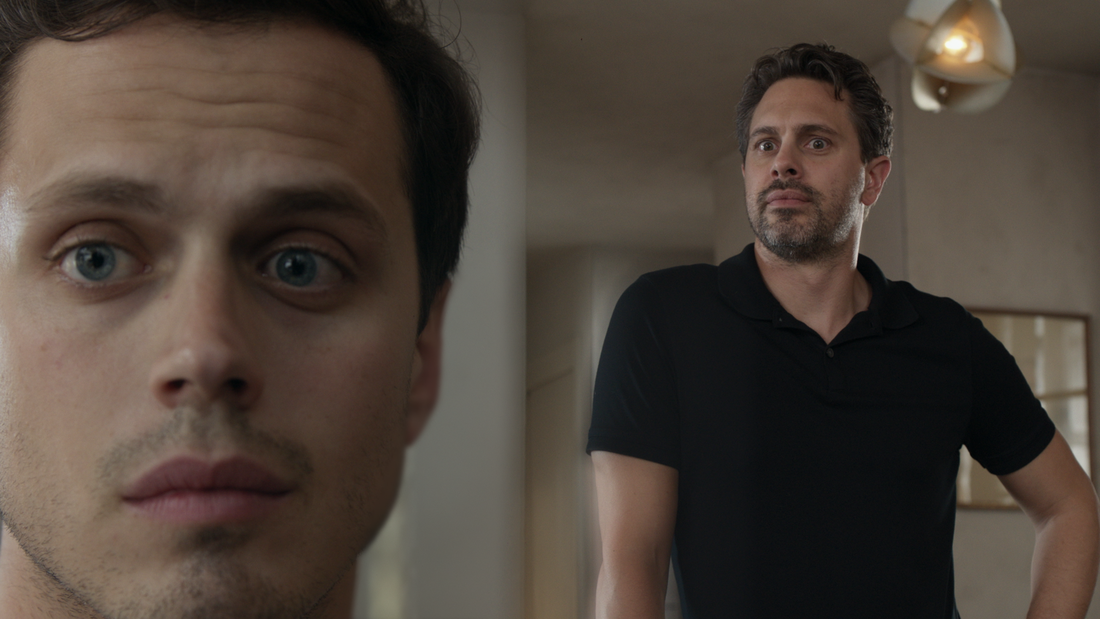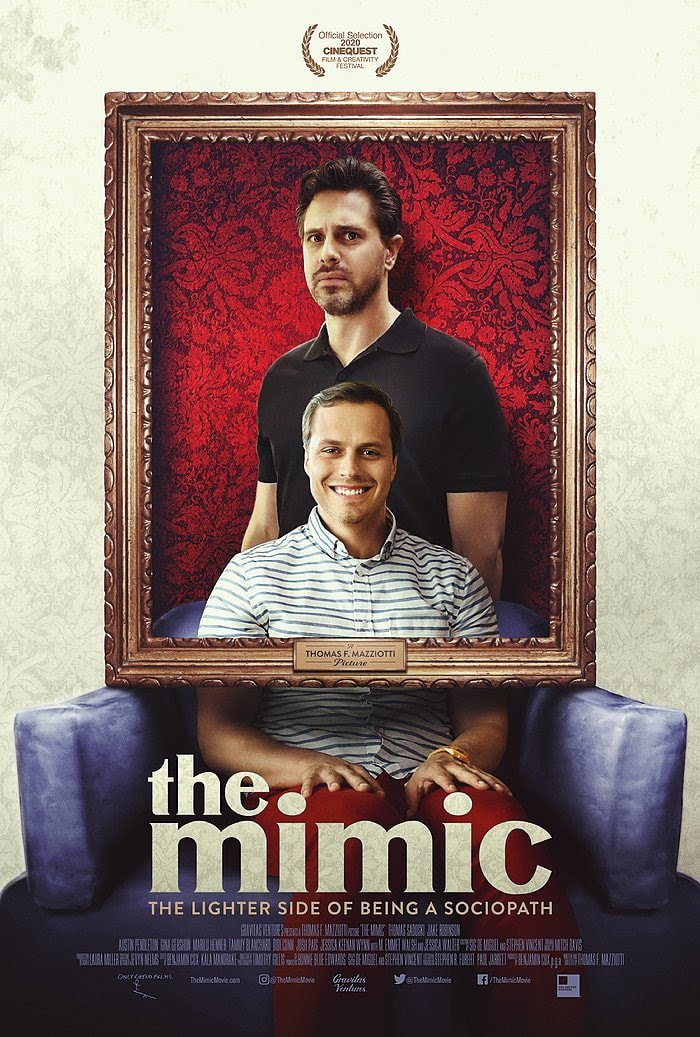|
The tagline for The Mimic, “the lighter side of being a sociopath,” boasts an intriguing story for anyone interested in representations of mental illness on screen. While this dark comedy from writer/director Thomas F. Mazziotti is not quite the informative and mental health-positive flick you might expect, The Mimic still has several interesting stylistic tidbits to offer. The story’s self-proclaimed narrator (Thomas Sadoski) is a brooding screenwriter and widower who becomes suspicious of the new guy in his neighborhood, referred to as “The Kid” (Jake Robinson). After both men attend a meeting for the community newspaper, The Kid starts following The Narrator around everywhere and popping up in the most unlikely places, leading The Narrator to believe that this unwanted “mimic” is a certified sociopath. However, The Narrator is also pining after The Kid’s young wife, who is characterized as a beauty so perfect that she cannot be shown on screen. As The Narrator takes a deep dive into obsessive research on sociopaths and even begins writing a screenplay about The Kid, it’s hard to tell if he is being stalked by his overeager new neighbor or if The Narrator is turning into a stalker himself. With dark humor and an obscure style, The Mimic is an off-beat, self-referential buddy comedy that touches on psychology and interpersonal relationships. The Mimic is structured by episodic bursts that, while splitting the story up into unique and memorable scenes, reveal important information about the characters in an unconventional manner that can be a bit confusing. While it’s far from a strict stream of consciousness piece, The Mimic is definitely more of a disorganized exploration of The Narrator’s thoughts than a straightforward narrative. Bits of important narrative information are casually dropped in at random times, as if the audience is supposed to read The Narrator’s mind and figure out important details ahead of time. The Narrator’s obsession with The Kid’s wife, for example, should give the story a delicious dramatic edge. But The Narrator brings up his feelings so quickly and randomly, and with so little development, that it doesn’t quite make the impact that it could. There’s also a pretty shaky sense of time in The Mimic. We don’t know for sure how much time has passed until the end, and it seems as though some key events and scenes have been cut out. What The Mimic lacks in narrative power, however, it makes up for in style. The Mimic toes the line between imaginative and absurdist, creating an almost fantastical visual style that supports the movie's dry humor. The Mimic's bright and oversaturated colors, paired with its whimsical score, create the feel of a fairytale or extended dream sequence and support the idea that we are, perhaps, inside of The Narrator’s head rather than watching the events of his life as an outside spectator. The dry, offbeat humor is one of The Mimic’s greatest strengths, particularly the running gag in which characters casually use the term “sociopath” as if it were a job title. “A sociopath,” one character says to The Narrator, “oh yeah, my brother-in-law is one of those.” While a few of the jokes are more wordy than witty, (more on that below), there are plenty of memorable, laugh-out-loud moments throughout The Mimic. Sadoski and Robinson deliver Mazziotti’s dialogue with a fast paced, rhythmic cadence that showcases both actors’ technical skills. Initially, the quick dialogue sounds witty, clever, and complex. However, it doesn’t hold up throughout the length of the film, despite Sadoski and Robinson’s notable delivery. The conversations in The Mimic are confusing and inconsistent, with quips and comebacks that seem out of place and off topic. The Mimic also watches like a filmed version of a play and focuses much more on dialogue and delivery than cinematography. Of course, this isn’t always a bad thing. There are many wonderful stage-to-screen adaptations that capitalize on the tricks and flourishes of the camera to fully transform a play into a film. However, The Mimic employs a sort of shot-reverse-shot whiplash during the scenes with quick dialogue, creating a sort of sensory overload that is difficult to follow. However, The Mimic clocks in at only 81 minutes, making the episodic bursts and disjointed dialogue a bit easier to digest. In its best moments, The Mimic is a philosophical journey through the mind of a grieving man. But, unfortunately, some of the story’s key themes don’t emerge until it’s too late to fully appreciate them. The movie puts so much emphasis on its fancy-sounding dialogue that we don’t get the chance to really connect with or understand the narrator. That being said, while The Mimic may not be the best movie to just sit down and watch for entertainment, it would be very interesting dissect and analyze scene by scene. While the style of The Mimic outshines the content, I applaud both of the lead actors for their performances as well as Mazziotti’s unique vision and his efforts to bring a serious subject to the screen in a more lighthearted manner. Screening in select theaters and available on VOD beginning Friday, February 5, 2021.
0 Comments
Leave a Reply. |
"Our embodied spectator, possibly perverse in her fantasies and diverse in her experience, possesses agency...finally, she must now be held accountable for it." Categories
All
|






